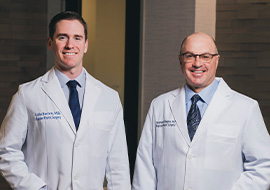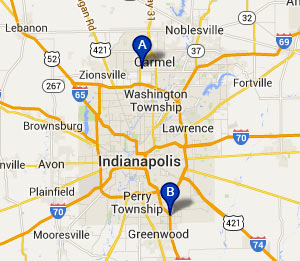Common Questions
Dr. Klapper and Dr. Bacorn specialize in cosmetic and reconstructive services of the eyelids and face.
Cosmetic surgical services include: Blepharoplasty; Endoscopic Forehead Lifting; Botox Injections; and Dermal Filler Injections (Radiesse and Restylane & Perlane). Specialized Skin Care Products (Jan Marini and SkinCeuticals) for use around the eyes are available at Klapper Eyelid & Facial Plastic Surgery.
Eyelid lifting typically refers to blepharoplasty surgery. Blepharoplasty surgery is performed to remove redundant tissue from the upper or lower eyelids. Cosmetic blepharoplasty is performed to provide a more youthful, rested eye appearance. Upper eyelid blepharoplasty, in some cases, may be covered by some insurance carriers or Medicare if significant visual field loss is caused by redundant upper eyelid skin.
Ptosis refers to a droopy upper eyelid where the upper eyelid margin is lower than normal and, in moderate to severe cases, may be covering part or all of the pupil. Ptosis repair may be covered by some insurance carriers or Medicare if significant visual field loss is caused by the abnormal upper eyelid position.
In most cases, patients may shower the day following surgery. Unless there is a dressing that should remain dry, then the operated areas can get wet. Hair washing can also be performed the day following surgery. if a brow lifting procedure or endoscopic forehead procedure were performed, then care should be taken to avoid scrubbing in the areas of the forehead incisions. Make-up should be avoided for 2-3 weeks near incision sites. Once scabbing and crusting has resolved then make-up may be applied to the operated areas.
When to return to an exercise routine after surgery will depend on the type of surgery performed, the progress of healing, and the form exercise that is planned. You will need to discuss specific concerns with Dr. Klapper or Dr. Bacorn as each patient’s circumstances will differ. Patients recovering from eyelid surgery may need to avoid most exercises for 1-2 weeks. Light to moderate exercising may be resumed at 2-3 weeks before beginning higher impact activities at 3-4 weeks. Swimming and diving should be avoided during the first 3-6 weeks after surgery.
Patients recovering from orbital surgery, such as fracture repair, will often need to wait up to 6 weeks or longer before resuming contact sports and significant physical activity.
Office procedures are performed with local anesthesia which may include eye drops and small injections under the skin in the area requiring surgery.
Surgeries performed in an ambulatory care center or hospital are usually performed with intravenous sedation administered by an anesthesiologist. Some surgeries, such as orbital procedures, are performed under general anesthesia.
Dr. Klapper or Dr. Bacorn will be able to discuss anesthesia options once a surgical plan has been developed.

Brow and Forehead Lift
Eyebrow Ptosis Correction and Forehead Lifting
The upper third of the face, which includes the forehead and eyelids, is the focal point of our facial expression and appearance. The eyebrow and eyelids may descend (or droop) for several reasons. Gravitational forces and familial facial characteristics each have an important role in the development of eyebrow “ptosis” (pronounced toe-sis) or droop. Over time, gravity may result in a gradual downward positioning of the eyebrows and a more full upper eyelid appearance. A less common cause of eyebrow ptosis is cranial seventh nerve palsy following trauma, surgery, or unknown causes (Bell’s palsy).
Why Consider Surgery to Elevate the Eyebrow and Forehead?
The downward positioning of the eyebrow can lead to full upper eyelids and contribute to excess skin in the upper eyelid area. This fullness may actually interfere with the superior visual field. Often times, downward descent of the eyebrow is the major contributor to upper eyelid skin redundancy and fullness and with surgical elevation of the eyebrow minimal eyelid skin may actually need to be removed. If significant eyebrow ptosis is present, eyelid surgery alone may not adequately improve eyelid fullness or expand the lateral or superior visual field (see Droopy Eyelids).
Elevation of the eyebrow and forehead can be an important procedure in reversing some of the aging changes of the upper face. An eyebrow or forehead lift can improve the “tired” look that may result from the degenerative changes of aging.
Which Procedures are Available to Correct Eyebrow Ptosis?
There are several different surgical approaches to elevate the eyebrow and forehead. The Direct Brow Lift involves an incision just above the eyebrow and provides the most direct elevation of the lateral eyebrow. A Mid-Forehead Lift involves an incision within the furrows (wrinkles) of the forehead. If concealing the incision sites is an important patient consideration, then a surgical approach designed at or behind the hairline is indicated. A Pretrichial Brow Lift uses incisions just in front of the hairline and works well for patients who comb their hair forward. The Endoscopic Forehead Lift with incisions concealed in the anterior scalp is the most frequently utilized cosmetic technique.
The Direct Brow Lift
The Direct Brow Lift involves incisions just above the eyebrow. Patients with thick eyebrows and significant lateral brow ptosis are good candidates for this procedure. Local anesthetic with or without intravenous sedation provides adequate anesthesia. A modified ellipse of tissue is removed from the area above the eyebrow, and the incision site is closed with nonabsorbable sutures. Nonabsorbable sutures diminish scarring in this area and require removal one week following surgery. Women may utilize makeup on the incision sites following suture removal. This technique is generally reserved for patients with very thick eyebrows or patients that have forehead muscle weakness requiring maximal lifting of the eyebrow area.
Mid-Forehead Brow Lift
The Mid-Forehead Lift involves incisions within the furrows (wrinkles) of the mid-forehead. Patients with deep furrows or rhytids and significant lateral brow ptosis are good candidates for this procedure. As with the direct approach, an ellipse of tissue is removed from the forehead and the incision site is closed with nonabsorbable sutures. Nonabsorbable sutures diminish scarring in this area and require removal one week following surgery. Women may utilize makeup on the incision sites following suture removal. Scars are well hidden in patients with deep furrows and gradually fade into the natural forehead wrinkles over the ensuing weeks to months.
Pretrichial Brow Lift
The Pretrichial Brow Lift utilizes incisions just in front of the hairline. It involves removal of an ellipse of tissue as with the mid-forehead technique. This is a good technique to elevate the brow in patients that do not have deep wrinkling of the forehead area and have a full hairline.
Endoscopic Forehead Lift
In the endoscopic forehead approach small incisions are made behind the hairline. This minimally invasive cosmetic technique is excellent for younger patients with few forehead wrinkles. It is also more effective for treatment of the medial portion of the eyebrow and glabellar region (area between the eyebrows). Endoscopic forehead elevation is typically performed under general anesthesia. The entire forehead and eyebrow is undermined and elevated with the use of an endoscope and video monitoring equipment. Incisions are made in the scalp just behind the hairline. The hair is not shaved or cut. No tissue is removed. The repositioned forehead is typically secured in place with a dissolvable implant fixated to the frontal bone. Scalp incisions are closed with staples that are removed 10-14 days after surgery.
What are Potential Complications of Forehead Surgery?
Temporary numbness of the forehead is common following all of the surgical approaches and typically improves over 1 to 4 months. Permanent numbness can occur but is rare. Damage to the facial nerve (nerve responsible for facial muscle contraction) can be damaged in the mid-forehead, pretrichial and endoscopic approaches and result in an upper facial droop. Fortunately, this is very rare. Postoperative bleeding and infection can potentially occur following any surgery. Over elevation, under elevation, and asymmetric eyebrow appearance are potential aesthetic concerns. Touch-up procedures may occasionally be necessary.
What is the Recovery Period for Forehead Surgery?
Patients undergoing direct, mid-forehead, and pretrichial brow lifts need to elevate the head and apply ice packs for 3 days following surgery. Heavy lifting and straining should be avoided during the first postoperative week. Suture removal is typically required at 1 week.
Following endoscopic surgery, icepacks are applied to the forehead for 3 days. Patients need to sleep with the head of the bed elevated for 2 weeks. Heavy lifting and straining should be avoided for 2 weeks. When to return to work will be based upon your occupation and what other procedures were performed at the time of your eyebrow lift. Generally, patients will need to wait up to 10 days before returning to most social and work activities.
Is Forehead Lift Surgery Covered by Insurance?
If eyebrow and forehead ptosis is severe typically seen as a result of a seventh nerve palsy (surgery, trauma, Bell’s palsy) and/or the eyebrow fullness interferes with the superior visual field, then brow surgery may be covered by some insurance carriers. In many cases, eyebrow surgery is considered cosmetic and not covered by insurance or Medicare policies of medical necessity. The direct, mid-forehead, and pretrichial surgical approaches are less expensive than the endoscopic procedure since they are more straightforward and do not require the operative time, implants, and costly equipment necessary to perform an endoscopic forehead lift.
Medicare patients electing to proceed with blepharoplasty, ptosis, or brow/forehead lifting procedures that do not appear to meet Medicare’s criteria for medical necessity will also be asked to sign Medicare’s Advance Beneficiary Notice of Noncoverage (ABN) indicating that the procedure(s) is(are) considered cosmetic, non-covered service(s) and will not be filed with Medicare. Secondary insurance carriers generally follow Medicare guidance.
The total cost of surgery will depend on which other procedures are performed at the same time, the facility selected for surgery, and the type of anesthesia.
Klapper Eyelid & Facial Plastic Surgery treats disorders, injuries, and other abnormalities of the eyelids, eyebrow, tear duct system, eye socket, and adjacent areas of the mid and upper face.

